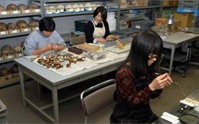

Researchers work on the measurement and restoration of human skeletal remains.
The Department of Ansthropology conducts research, mainly from a biological perspective, on issues such as the evolutionary history of the human species; human beings living in the world today; and origins of the Japanese people. The research structure comprises of five researchers under a Director who make up the Division of Human Evolution that conducts various kinds of research in areas such as morphology and genetics.
In addition to conducting surveys and carrying out research, the members of the Division also engage in the collection of materials that form the basis of their research, and management of specimens.
Most of the specimens in the Division's collection, that are used extensively by researchers in Japan and from overseas, are human skeletal remains from each historic period in Japan beginning with the Jomon Period. Other activities of the Division include updating the exhibits at the Ueno Main Building; planning special exhibitions; and supporting numerous educational programs that target a wide range of people from children and students to school teachers.
- Functional morphological research on teeth of primates including humans:
- Research on molar size and shape variations among humans, extant apes, and fossil specimens, using three-dimensional comparative analysis.
- Three-dimensional digital analysis of cranial morphology:
- Analysis of human and ape cranial morphology using information from CT (Computed Tomography) images.
- DNA analysis of great apes:
- Research to study the intra-species genealogy and community structure of great apes using mitochondrial DNA analysis.
- Research on early human fossils in Asia:
- Field surveys and morphological research on early human fossils in Indonesia, in order to study their evolutionary history in the Asia region.
- Research on human skeletal remains from the Paleolithic period in Japan:
- Surveys of Minatogawajin fossil remains that were unearthed in Okinawa to learn more about the first people who came to the Japanese islands in or before the Jomon Period.
- Study of changes in cranial morphology by era and statistical analyses of the causes:
- Study of changes in physical traits of extant humans by regional community and era, with a focus on changes in cranial characteristics, and whether those changes were environmental adaptations; and multivariate statistical analyses to reveal the specific causes of environmental adaptations.
- Analysis of ancient DNA samples to elucidate the origins of the Japanese people; and molecular anthropological research of indigenous people in the Andes region:
- Analyses of remnant DNA from ancient human skeletal remains to research Homo sapiens migration and diffusion, and the formation of communities.
- Research on the evolution process of the Japanese people based on geographical variations in skeletal morphology:
- Research into the effects of radical changes in the living environment of the Japanese people since the agricultural revolution on physical traits and health, through surveys of their skeletal morphology change patterns by era, from the prehistoric times to the modern day.
- Development and verification of methods to estimate age from human bone morphology; establishment of methods to assess personal lifestyles by studying human skeletal remains:
- Forensic and palaeoanthropological research into methods to estimate a person's age at the time of death; physical height, gender, and other characteristics, from skeletal remains.
Human skeletal remains belonging to different time periods excavated from various regions constitute the major part of the specimen collection. In particular, the division has actively collected human skeletal remains from within Japan that it stores and manages to conduct several kinds of research. With regard to human skeletal remains from other countries, researchers collect specimens through joint surveys with overseas researchers, and, in principle, conduct research within the particular country. There are also replicas of fossilized human skeletons, and archaeological and fingerprint-related materials. Information on the specimens and other material has been disclosed worldwide, and the Department of Anthropology engages in exchange programs between anthropologists from research organizations across the globe and researchers from the department.